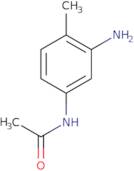
Informação sobre produto
- 1-(2-Fluorophenyl)-3-{5-[(4-Nitrophenoxy)Methyl]-1,3,4-Thiadiazol-2-Yl}Urea
- 2-Amino-4-acetylaminotoluene
- 3'-Amino-4'-methylacetanilide
- 3′-Amino-p-acetotoluidide
- 4-Acetylamino-2-aminotoluene
- 4-Acetylamino-2-toluidine
- 5-Acetamido-2-methylaniline
- Acetamide, N-(3-amino-4-methylphenyl)-
- Acetanilide, 3'-amino-4'-methyl-
- Ba 8315
- Ver mais sinónimos
- Brn 2804114
- Ccris 2681
- N,N'-(2,2-dimethylpropane-1,3-diyl)bis(3-phenylprop-2-enamide)
- p-Acetotoluidide, 3′-amino-
Acetaminophen, also known as paracetamol, is a widely used drug for pain relief and fever reduction. It is metabolized by the liver, mainly through the cytochrome P450 pathway. The cytochrome P450 pathway produces reactive intermediates that can cause oxidative stress and DNA damage. Acetaminophen has been shown to be toxic to rat primary hepatocytes in vitro at concentrations of 40-160 μM after 24 hours. Acetaminophen has also been shown to be mutagenic and carcinogenic in rats at doses of 5000 mg/kg/day, which is equivalent to a human dose of 160 mg/kg/day or higher. These effects are due to acetaminophen’s metabolic activation by reactive oxygen species (ROS) and its ability to induce cytotoxicity and oxidative stress in cells.
Propriedades químicas
Consulta técnica sobre: 3D-GAA37516 N-(3-Amino-4-methylphenyl)acetamide
Se desejar solicitar um orçamento ou fazer uma encomenda, por favor, adicione os produtos ao seu carrinho e depois solicite um orçamento ou encomenda a partir do carrinho. É mais rápido, mais barato e poderá beneficiar-se dos descontos e outras vantagens disponíveis.





